When Do Boxer Dogs Go Into Heat? [Explained]
Boxer dogs experience a heat cycle, just like other breeds. Female dogs usually go into heat for the first time at around 6 to 9 months of age. However, some Boxer dogs may experience their first heat cycle a bit later, closer to 12 months old.
The heat cycle, or estrus, is a natural process that indicates when a female dog is receptive to breeding. For Boxer dogs, this cycle typically occurs twice a year.

The heat cycle consists of four stages: proestrus, estrus, diestrus, and anestrus. Let’s break down these stages for a better understanding:
- Proestrus: This stage lasts around 9 days and is marked by swollen vulva and bloody discharge. Male dogs become attracted to the female, but she won’t be receptive yet.
- Estrus: During this stage, the female Boxer becomes receptive to mating. This phase lasts around 9 days, with the discharge lightening in color. This is the prime time for breeding.
- Diestrus: Lasting about 60 days, the diestrus stage is when the female dog is no longer receptive to mating. If fertilization occurred, this is when pregnancy starts.
- Anestrus: This is the resting phase between cycles, with no hormonal activity or physical changes. Anestrus lasts around 4 to 5 months for Boxer dogs.
It is crucial to understand your Boxer dog’s heat cycle to ensure responsible breeding and prevent unwanted pregnancies. For male Boxer dogs, it’s essential to keep them separate from females in heat to prevent unintentional breeding, which can cause stress for both dogs and their owners.
Being prepared for your Boxer’s heat cycle can make life easier for both you and your four-legged friend. Remember that love is in the air during this cycle, and responsible pet parenting can save you from any unexpected puppy surprises! So keep an eye on your Boxer’s behavior, and you’ll navigate the heat cycle like a pro.
Physical Signs of Heat in Boxer Dogs
As a Boxer dog owner, understanding the physical signs of your furry friend going into heat can be quite helpful. In this section, we’ll discuss some of these telltale signs, including the swollen vulva and discharge, blood-tinged discharge, and increased urination. So, grab your detective hat and let’s dive in!
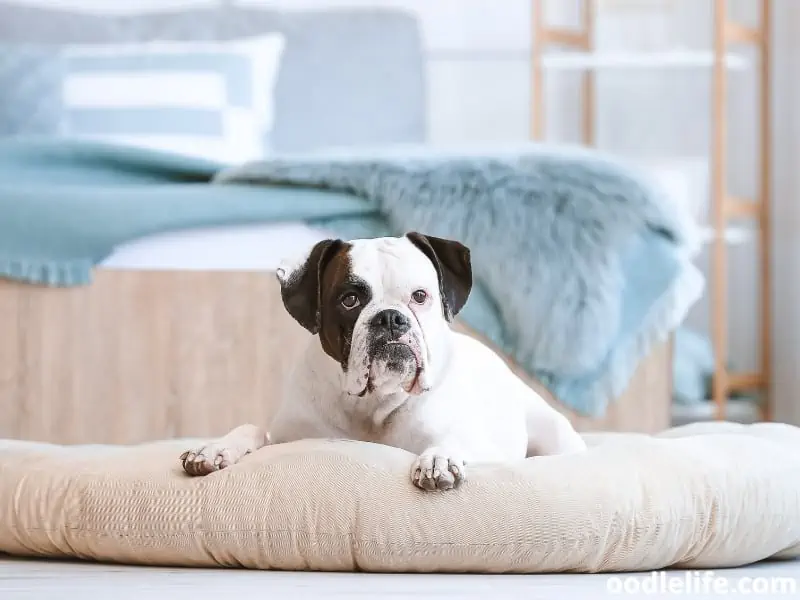
Swollen Vulva and Discharge
One of the most noticeable signs that your female Boxer is entering her heat cycle is a swollen vulva. This change can be quite apparent, even to the untrained eye. You might see your dog giving the area some extra attention, licking it more often than usual.
Along with the swelling, you may also notice a clear or milky discharge, which is your pup’s body prepping for potential breeding. Don’t be surprised if she seems a bit more affectionate or clingy during this time – she’s just following her natural instincts!
Blood-Tinged Discharge
As your Boxer progresses through her heat cycle, that clear or milky discharge may turn into a blood-tinged discharge. This is absolutely normal and a clear sign that she’s in heat. Don’t panic if you see some red spots around the house, it’s all part of the process.
To help keep things clean, you can use doggy diapers, or simply embrace your inner Sherlock and track her movements with an air of mystery and intrigue.
Increased Urination
Another sign to watch out for is increased urination. Your female Boxer may suddenly start peeing more frequently than usual, to the point where you might feel like you’re taking her out for walks every five minutes! This increased urination isn’t a sign of a rebellious attitude, but rather her body’s way of telling potential mates, “Hey, I’m available!” through scent marking.
In conclusion, by keeping an eye on the swelling of the vulva, any discharge (especially if it becomes blood-tinged), and an uptick in urination, you’ll have a clear idea of when your Boxer dog is in heat. So, get into your investigator mode, pay attention to these signs, and help her navigate this hormonal roller coaster with ease!
Behavioral Changes During Heat
During a Boxer dog’s heat cycle, you may notice several behavioral changes. Some of these changes include increased affection or irritability, flagging, and mating behavior. It’s important to be aware of these behaviors in order to best care for your dog during this sensitive time.
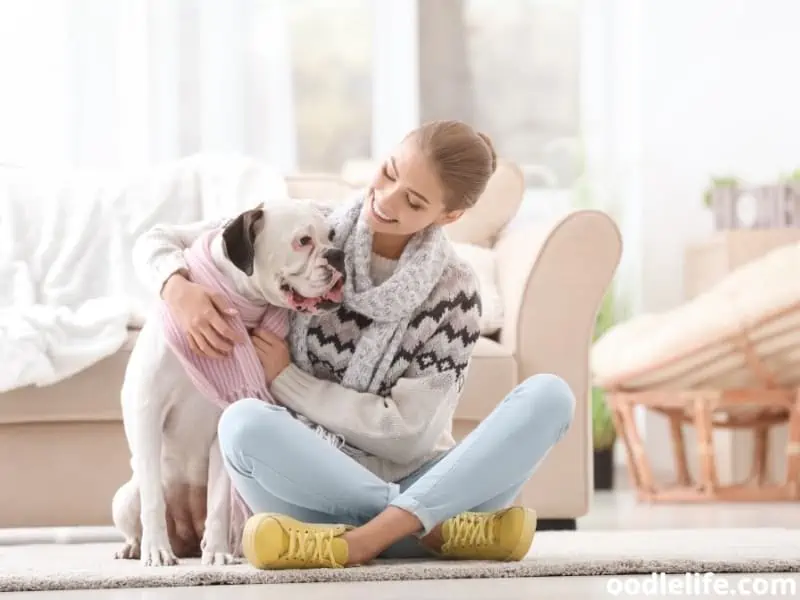
In this section, we’ll go through each of these behavioral changes in detail.
Increased Affection or Irritability
Boxer dogs, like other breeds, may become either more affectionate or more irritable when they are in heat. Some dogs may seek more attention, while others may become grumpy and prefer to be left alone. For example, your usually happy-go-lucky Boxer might suddenly start showing unusual signs of aggression or irritation, such as growling when you try to cuddle them.
On the other hand, your independent Boxer might suddenly turn into the ultimate cuddle bug, seeking your attention and affection at every turn. It really depends on your dog’s personality and experiences.
Flagging
“Flagging” is a behavior that female dogs display when they’re in heat to signal their readiness for mating. A Boxer dog in heat may begin to lift her tail, revealing her vulva, and hold it in a particular angle to the side. This behavior is called flagging because it’s as if your dog is waving a little flag—just a metaphorical one, of course.
You can keep an eye out for this behavior, as it shows that your Boxer is in the middle of her cycle. But, don’t worry! She’s not going to morph into a semaphore expert, and your secret messages are safe.
Mating Behavior
During heat, a Boxer dog may display some mating behaviors even if a male dog is not around. This could include “flirting” with humans or other dogs, raising her rear end, or even trying to mount another dog or object. It may be amusing or a bit awkward, but this behavior is just their natural instinct in response to hormonal fluctuations.
Just remember that while your fur baby is acting like the dog equivalent of a lovesick teenager for a brief time, it’s just a temporary phase. Be patient and give them the understanding and support they need during this time.
The Four Stages of a Boxer Dog’s Heat Cycle
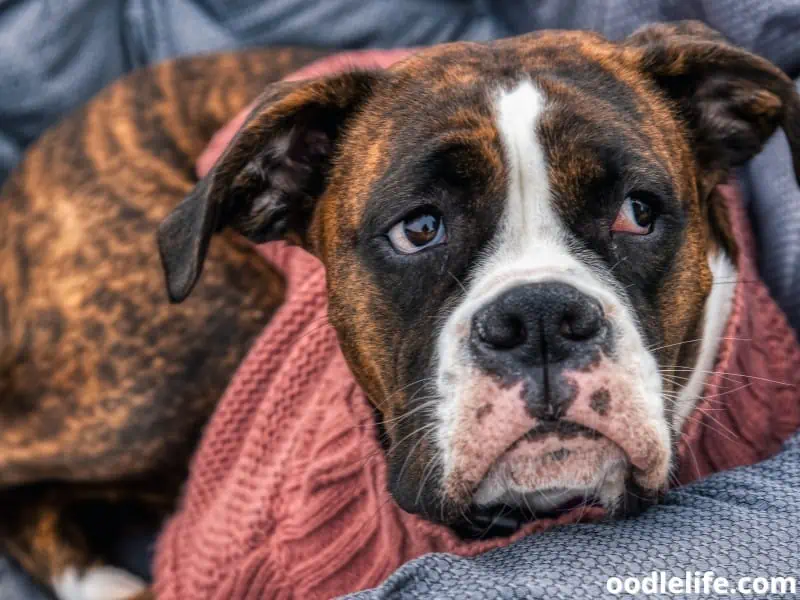
Proestrus
During the first stage called proestrus, your confident and bold Boxer dog starts to show initial signs of entering the heat cycle, which usually lasts for 7 to 10 days. You might notice her becoming more clingy or moody, and she may begin to show swelling around her vulva and bloody discharge. This is when her estrogen levels rise, and although she isn’t ready for mating, male dogs will begin to show interest in her.
Estrus
In the next stage, estrus, your Boxer dog truly becomes the belle of the ball. Usually occurring around 10-17 days into the cycle, she’s now receptive to mating as her estrogen levels peak and begin to drop. Proportional to the rise of progestin hormones, this phase usually spans around 5 to 9 days.
At this point, her discharge might transition from bloody to a straw-colored fluid. Remember, this is the prime time when she can become pregnant, so keep a watchful eye on her!
Diestrus
Once the party is over, your Boxer dog enters the diestrus phase. This stage typically lasts for 6 to 10 weeks and is marked by a sharp decrease in estrogen levels and increase in progesterone. Whether she has mated or not, her body will assume she’s pregnant.
Thus, she might exhibit signs of phantom pregnancy like nesting behavior, even when she’s not pregnant. No need to be alarmed, it’s just her hormones playing tricks on her.
Anestrus
Finally, your Boxer dog takes a well-deserved break in the anestrus phase, a neutral period where she’s both physically and hormonally resting. This phase typically lasts between 4 to 5 months, giving her body time to recover before the inevitable next heat cycle.
So, there you have it! The four stages of a Boxer dog’s heat cycle. While each pup is unique, understanding these hormonal twists and turns helps you and your Boxer navigate this natural process with knowledge, clarity, and confidence.
Enjoy the journey!
Frequency and Duration of Heat Cycles
When it comes to our beloved Boxer dogs, keeping track of their heat cycles is crucial for their health and well-being. So let’s talk about frequency and duration of heat cycles in these incredible canines.
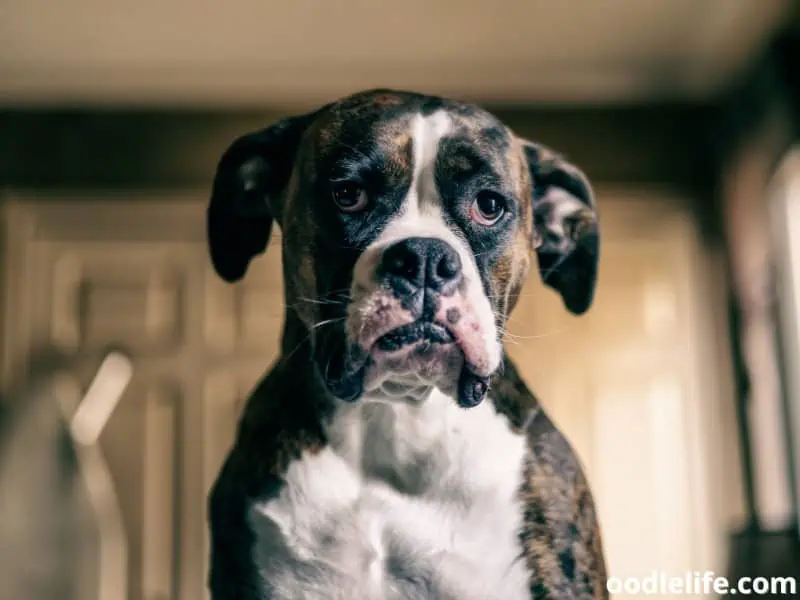
Boxer dogs usually experience their first heat cycle between 6 and 8 months of age, but it’s not uncommon for it to happen a little earlier or later. Just like humans, every dog is unique, so don’t fret if your Boxer falls outside this range.
On average, Boxer dogs go into heat twice a year. However, the frequency can vary from dog to dog and even from year to year. In terms of how often your dog will go into heat, the twice-a-year rule is a good guideline, but it’s wise to keep an eye on your pup because there can always be some variation.
Now, let’s talk about the duration of heat cycles in Boxer dogs. Typically, this lasts for about 2-4 weeks, with the peak period lasting for approximately 9 days. During this peak, your dog is most fertile and receptive to mating.
But remember, it’s not an exact science, and every dog has its own unique schedule.
In short, Boxer dogs generally go into heat for the first time between 6 and 8 months of age, with heat cycles occurring roughly twice a year and lasting for around 2-4 weeks. As a loving Boxer parent, it’s essential to familiarize yourself with your dog’s cycles to ensure their health, happiness, and avoid any unplanned puppy surprises!
So now that you’re informed, confident, and knowledgeable on the topic of heat cycles in Boxer dogs, it’s time to strut your stuff and show your pup you’ve got this handled. After all, that’s what being a top-notch dog parent is all about!
Caring for a Boxer Dog in Heat
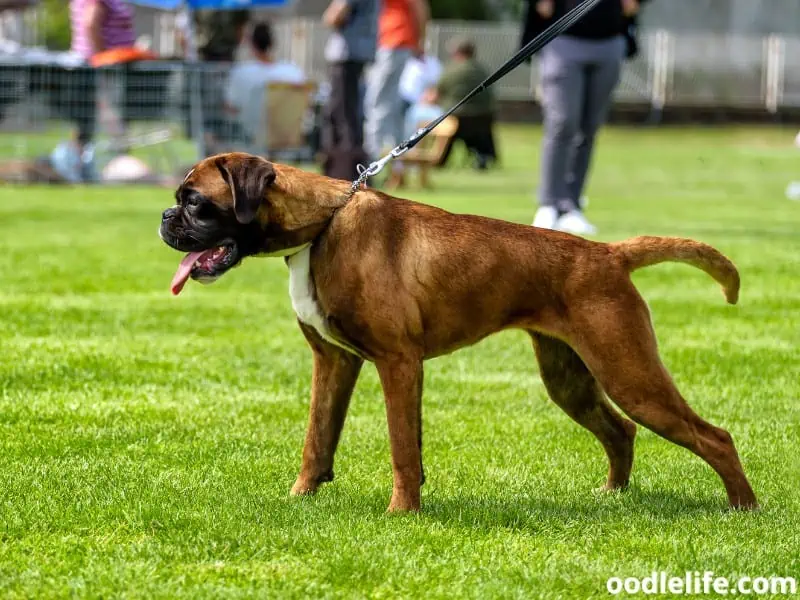
Using Diapers and Towels
When your Boxer goes into heat, it’s important to manage the mess. Doggy diapers are a great solution for keeping your home clean and your dog comfortable. These can be found at your local pet store or online.
It’s like a fashion show for your pup, but with a purpose! Keep some towels handy too – they’re great for cleaning up any occasional “oops” moments or for placing beneath your Boxer when they’re resting.
Supervision and Leash Use
During this time, keep a close eye on your Boxer. Her behavior might change, and she may try to find ways to escape and meet potential mates. Channel your inner Sherlock Holmes and regularly check your yard for any possible exit routes.
Avoid off-leash walks during this time. Instead, make sure to keep your dog on a leash when outside. The motto here: better safe than sorry!
Hygiene and Cleaning
Maintaining good hygiene is essential during your Boxer’s heat cycle. Regularly check her diaper and change it as needed. Don’t forget to keep her living and sleeping areas clean.
Providing her with a comfortable bed that’s easy to clean will make your life easier. Remember, a clean dog is a happy dog – and a happier owner too!
Maintaining Comfort
Just like humans, dogs appreciate some extra TLC during this time. Make sure your Boxer has access to fresh water and monitor her exercise levels. Avoid pushing her too hard, but don’t let her become a couch potato either – a good balance is key.
Keep her comfortable by making sure she’s not too hot or too cold. If she seems to be in pain, consider a trip to the vet to ensure her health and wellbeing.
It’s important to plan and be prepared for when your Boxer goes into heat and to follow the above advice. By providing a clean, comfortable, and supervised environment, you are sure to have a smooth experience even during this challenging time. And remember, if you decide to have your dog spayed, you can say goodbye to heat cycles altogether!
Just make sure to consult with your vet to determine the best option for your Boxer.
Health Concerns During Heat
Boxer dogs typically experience their heat cycle twice a year, and during these periods, they become susceptible to various health issues. It’s crucial for pet owners to monitor their Boxer dogs and remain vigilant about any signs of trouble to ensure their dog’s well-being.
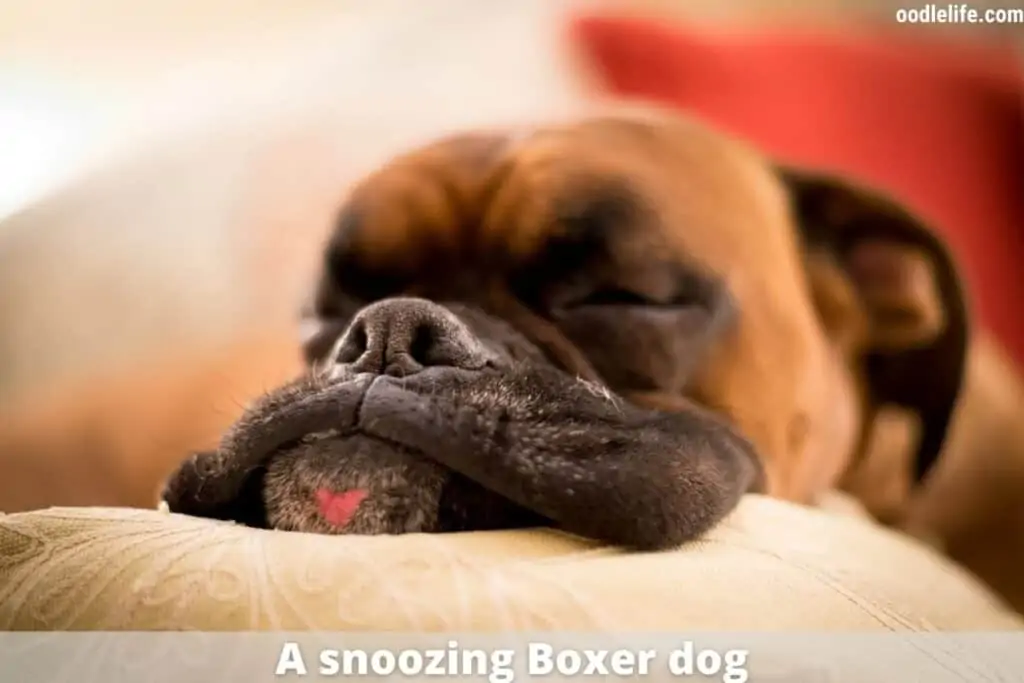
Pyometra and Infections
Pyometra is a severe infection affecting the uterus that can occur during heat. Better safe than sorry, so keep an eye out for symptoms like lethargy, vomiting, excessive thirst, and a foul-smelling discharge. If any of these signs appear, it’s time to rush to the veterinarian!
Early treatment often involves antibiotics and could eventually lead to spaying the dog to prevent future complications.
Mammary Cancer
You might not know this, but Boxer dogs are at risk of developing mammary cancer – an issue far from being the breast of their problems. To keep your dog healthy, routinely check for any unusual lumps, bumps, or swelling on their mammary glands. Like humans, early detection of mammary cancer increases the chances of successful treatment.
So, always stay one step ahead by regularly scheduling veterinary checkups!
Reproductive Issues
Much like a soap opera, a Boxer dog’s reproductive system can experience its fair share of dramatic twists and turns. Issues such as failure to conceive or complications during pregnancy may arise, but regular visits to the veterinarian are key in navigating these challenging times. Providing the right care and attention will not only minimize potential problems but will also ensure a healthy and happy mother-to-be.
Who let the dogs out? While that question may remain unanswered, one thing is certain: maintaining your Boxer dog’s health during their heat cycle is paramount. By diligently monitoring for any potential issues and seeking veterinary care when necessary, you’ll be well on your way to keeping your furry friend in tip-top shape.
Breeding and Pregnancy in Boxer Dogs
Boxer dogs, like most breeds, go into heat approximately every six months. You can tell if your female Boxer is in heat by checking for a swollen vulva and increased bleeding or discharge. Now, while you might think she’s just going for a new fashion statement, swollen areas is actually one of the tell-tale signs of the heat cycle.
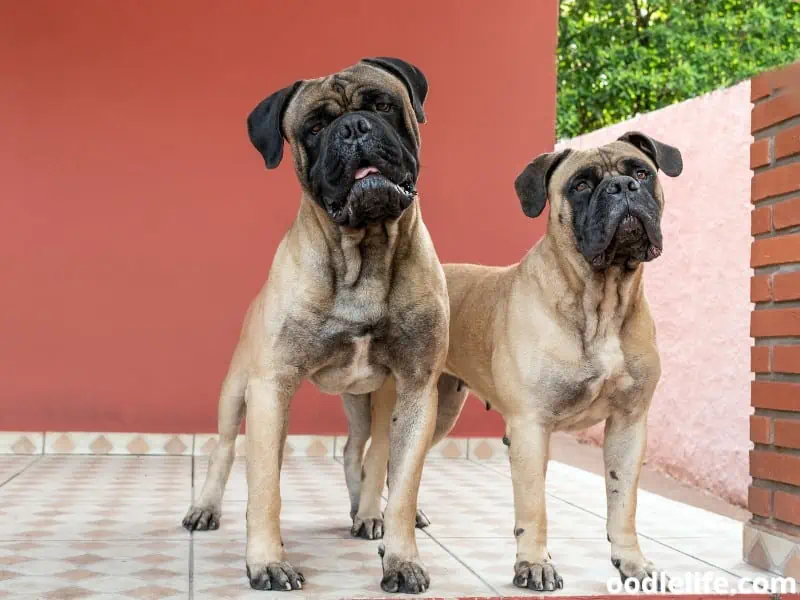
When it comes to breeding, timing is crucial. If ever there was a “Goldilocks” moment, this would be it – not too early, not too late, but just right. Mating between your Boxer dogs should be ideally planned around the 10th or 11th day of the heat cycle.
But don’t sweat it, if you missed the date, there’s always the next cycle!
So your Boxer duo had a romantic encounter, and now you’re hoping for some cute little puppies. A few weeks into the pregnancy, you might notice your beloved dog’s belly expanding as if it were Thanksgiving every day. However, size isn’t everything – depending on the number of pups your Boxer is carrying, she may not balloon up too much!
During pregnancy, Boxer moms-to-be may start to build a nest in anticipation of giving birth. It’s like they’re channeling their inner HGTV host, trying to create the perfect cozy den for their soon-to-be-born puppies. Just remember to provide them with a comfortable and safe whelping box to welcome their little ones into the world.
While the prospect of new, tiny Boxer additions can be exciting, not all pet owners want to deal with the responsibility of raising puppies. If you’re not planning on breeding your female Boxer, it’s best to consider having her spayed early on. Not only does this help curb her desire to go on endless romantic escapades, but it can also lead to potential health benefits, as spaying can reduce the risk of certain medical conditions.
In conclusion, breeding and pregnancy in Boxer dogs can be an exciting and enriching experience, both for the dogs and their human companions. Just remember to pay attention to the signs, be mindful of timing, and provide a comfy, safe space for your pregnant pooch. After all, every Boxer mama deserves the best!
Spaying and Preventing Heat Cycles
If you have a female Boxer dog, you might want to consider spaying to prevent heat cycles and unwanted litters. Spaying is a surgical procedure that removes the ovaries and uterus in an intact female dog. This procedure not only prevents pregnancies but also eliminates the heat cycles that can be quite a hassle for both the owner and the dog.
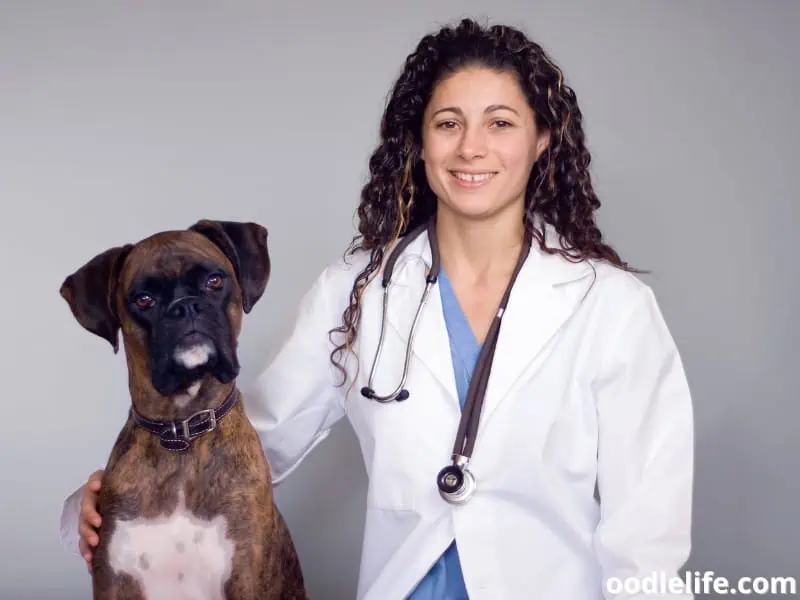
Spayed dogs don’t go into heat, which means no more worry about your buddy attracting all the males in the neighborhood. Forget about your white carpet looking like a crime scene every few months, and your dog wearing cute but uncomfortable diapers during her cycle. It’s a win-win situation!
Recovery time after spaying usually lasts for around ten days, during which your dog should be kept calm and restricted from intense physical activities. Make sure you follow your vet’s instructions and watch for any signs of infection or complications. Be prepared for some boredom-induced puppy dog eyes, but don’t worry; they’ll be back to their energetic selves in no time.
In addition to eliminating heat cycles, spaying has several health benefits, such as reducing the risk of certain reproductive cancers. However, it’s essential to consider the timing of the procedure. While some vets may recommend early spaying (before the first heat cycle), others might suggest waiting until your dog reaches a certain age or has experienced a specific number of cycles.
Deciding when to spay your Boxer ultimately depends on you and your veterinarian’s recommendations. Talk to your vet about your dog’s specific needs, and they’ll help you determine the best course of action. Remember, a spayed female dog is not only a happier one but also a healthier one.
So, put on your confident face, armed with your newfound knowledge, and give your Boxer the best life possible.